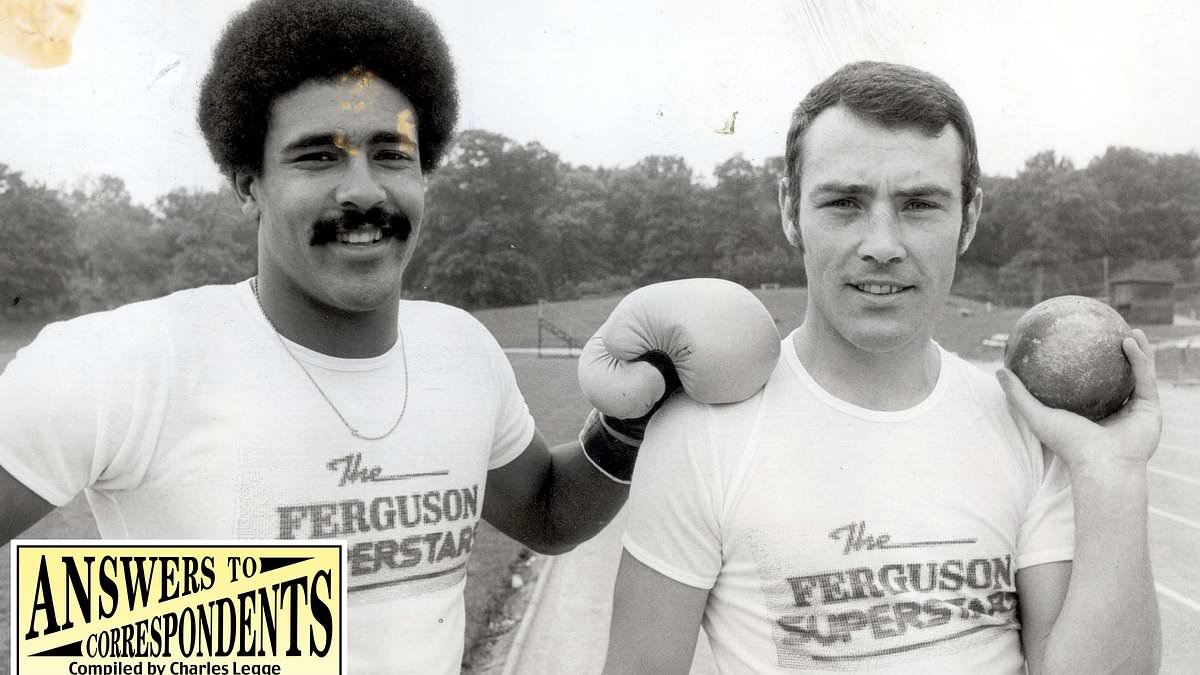QUESTION: Does anyone remember a TV programme where the likes of Daley Thompson and Geoff Hurst competed in a series of sporting challenges?
This was BBC’s Superstars, a show that tapped into the idea of seeing athletes from one sport try their hand at others. David Vine and Ron Pickering hosted it for 12 years between 1973 and 1985.
Competitors participated in various events, including a 100-metre dash, half-mile run, weightlifting, rowing, shooting, swimming and the infamous ‘Gym Tests’.
The first Superstars was won by 1968 400m hurdle Olympic champion David Hemery. He defeated Jackie Stewart (F1), Bobby Moore (football), Joe Bugner (boxing), Roger Taylor (tennis), Tony Jacklin (golf) and Barry John (rugby union).
Sportsmen such as Kevin Keegan (football), Brian Jacks (judo) and Daley Thompson (decathlete) were iconic competitors. Keegan’s wipeout on a bicycle was one of the most memorable TV moments of 1976.
Jacks was a fan favourite — his domination of the gym-based challenges became the stuff of legend. He won the show twice. Other winners included boxer John Conteh, rugby league player Keith Fielding, pole vaulter Brian Hooper and swimmer Robin Brew.
Q: Where was the apartment block used in the film Rosemary’s Baby? Why did Ira Levin call it Bramford?
Mal Hopkinson, Bexhill-on-Sea, East Sussex
Q: Is the word jovial related to the planet Jupiter?
Leigh Daniels, Nantwich, Cheshire
Q: What is the most surprising dish someone has accidentally ordered at a restaurant?
Hilary Thomas, Peterborough
There were various spin-offs, including celebrity and international editions and, although it experienced a brief revival in the early 2000s, its original run is considered the golden era of the show.
Tamara Baker, Sevenoaks, Kent
QUESTION: Which capital cities are geographically closest?
The conclusive winner is Vatican City and Rome because one is inside the other and therefore zero distance apart.Vatican City became a recognised country under the terms of the Lateran Treaty, signed in 1929, which ended decades of dispute over the Vatican’s political and legal status within Italy. However, if we look at neighbouring countries, there are several contenders because straight-line distance is sometimes not the same as distance by road.
Kinshasa, in the Democratic Republic of the Congo (DRC), and Brazzaville, the capital of the Republic of the Congo, areseparated only by the Congo River, with the border running down the middle of the river. However, travelling from one city to the other involves a journey of several miles in order to reach the nearest bridge and therefore cross the border.
In Europe, the two closest capital cities are Bratislava in Slovakia and Vienna in Austria, which are just 34 miles apart.
Bob Cubitt, Northampton
QUESTION Which is the oldest working whiskey distillery?
In the 12th century, Henry II noted upon his invasion of Ireland that the monks would make and drink ‘uisce beatha’ which is Gaelic for ‘water of life’ (Latin aqua vitae). Northern Ireland claims to have the oldest licensed distillery in the world, Bushmills, which was granted a licence to distil whiskey in 1608 by King James I.
Uisce beatha had been made in the area for centuries. Whiskey production was a way for farmers and smallholders to use up surplus grain, and the resulting liquid could be traded or consumed for pleasure.
Yet Bushmills’ origins are somewhat removed from the current business. The original licence was granted to English knight Sir Thomas Phillips (c.1560-1636), who had arrived in Ireland in 1599, and the reality of his licence to distil was that it gave him a monopoly by making it illegal for anyone else to make whiskey on his lands unless they sub-let the licence from him at a cost.
The modern Bushmills distillery wasn’t founded until 1784. Its name comes from the mills scattered along the River Bush, the water of which is used during the distillation process.
In Scotland, the earliest historical reference to whisky comes from the 1494 Scottish Exchequer Roll, where there is an entry of ‘eight bolls of malt to Friar John Cor wherewith to make aqua vitae’.
Many of Scotland’s iconic distilleries were making whisky long before they became licensed, but the official line is that the three oldest distilleries in Scotland are Glenturret in Perthshire (1763), Bowmore on Islay (1779) and Strathisla in Speyside (1786).
All three have operated from the same location since being founded. Glenturret and Bowmore have both gone through periods when they were dormant.Strathisla, on the other hand, has operated continuously since its founding and has good grounds to claim seniority.
Mark Murphy, Aberdeen
